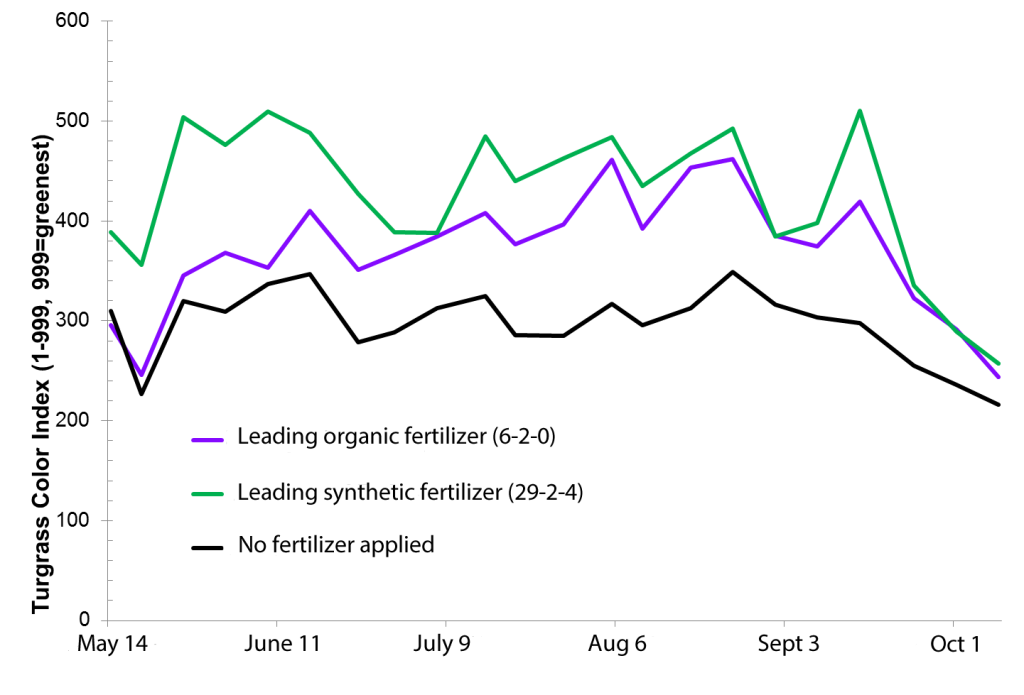 Dr. Doug Soldat, turfgrass researcher and extension specialist for the University of Wisconsin, discusses the ins and outs of organic fertilizers and their benefits.
Dr. Doug Soldat, turfgrass researcher and extension specialist for the University of Wisconsin, discusses the ins and outs of organic fertilizers and their benefits.
July is a great time to feed your lawn with an organic fertilizer. Not only will it improve the look of your lawn, it may, also, make it more environmentally friendly. As a turfgrass researcher and extension specialist at the University of Wisconsin, I study anything and everything related to growing grass to meet aesthetic and functional goals while protecting the environment. My research, and that of many others, has shown that a dense lawn best reduces runoff losses of phosphorus that can pollute fresh water lakes and streams. Phosphorus adheres tightly to soil particles that can detach from a thin lawn as water from snow melts or rainstorms flow over the lawn. Thicker lawns form a barrier between the water and soil and, also, slow the flow of water allowing more to soak into the ground. Typically, one or two annual fertilizer applications achieve the density required to reduce phosphorus losses.
Organic fertilizers derive from animal and plant material; common sources include composted poultry or dairy manure, fish bone meal, blood meal, feather meal, biosolids, or corn gluten meal. As nutrient rich by-products that would otherwise need to be landfilled or incinerated, recycling organic fertilizers into your lawn makes a lot of sense. Organic fertilizers often contain a high percentage of slow release nitrogen, which stimulates and utilizes soil microbes that slowly turn the fertilizer into plant available forms of nitrogen–i.e. ammonium and nitrate–at a pace that matches the plants ability to absorb it. This means that very little of the fertilizer will likely leach into the groundwater.
While slow release synthetic fertilizers exist, the less expensive synthetic fertilizers tend to contain mainly soluble forms of nitrogen. One benefit of a fertilizer with high soluble nitrogen content is that you get rapid plant response at colder temperatures (i.e. spring) as seen in the graph below where we compared the leading organic fertilizer to the leading brand of synthetic fertilizer. On the graph, the higher the color index, the greener the lawn. Early in the spring the synthetic fertilizer treated lawn is greener than the lawn treated with the organic fertilizer. However, by mid-summer and for the rest of the season very few differences between the two fertilizers persist.

We’ve studied dozens of different organic lawn fertilizers at the University of Wisconsin and found a wide range in characteristics and responses. Some organic fertilizers contain no soluble nitrogen at all. Others, particularly poultry manure based fertilizers can contain up to 40% soluble nitrogen. We’ve noticed that you can expect a more rapid greening response as the percentage of soluble nitrogen increases. While far too many organic fertilizers exist to list or rank, I suggest finding a few locally (or regionally) produced fertilizers and then choose one from that group that contains some soluble nitrogen. This will give your lawn a quick boost along with a sustained response from the slow release component. Using a local product means a shorter transportation distance and a lower carbon footprint.
What about phosphorus?
Phosphorus is a major pollutant of freshwater bodies. Many Midwestern states have passed laws restricting or banning the use of lawn fertilizers containing phosphorus. If a soil test shows adequate phosphorous levels, then using a phosphorus containing fertilizer is unnecessary and potentially harmful to water quality. Some states exempt organic fertilizers from the phosphorus rules, but not because they are particularly less harmful than their synthetic cousins. Phosphorus-free organic sources include blood meal, feather meal, and corn gluten meal, among others. Regardless of phosphorus content, make sure to sweep up any fertilizer thrown or spilled on the street, sidewalk, or driveway. Fertilizer left on these surfaces quickly makes its way into a body of water.
In conclusion, an organic fertilizer can be an excellent tool for maintaining a healthy lawn. They contain nutrients that the lawn needs, and release those nutrients slowly at a pace that the lawn can absorb – especially in mid-summer. Keeping your lawn dense will not only look good and provide a nice space to enjoy but will, also, keep the soil in place and the weeds out. If you haven’t fertilized your lawn in a while, consider going organic this summer to do the job!
